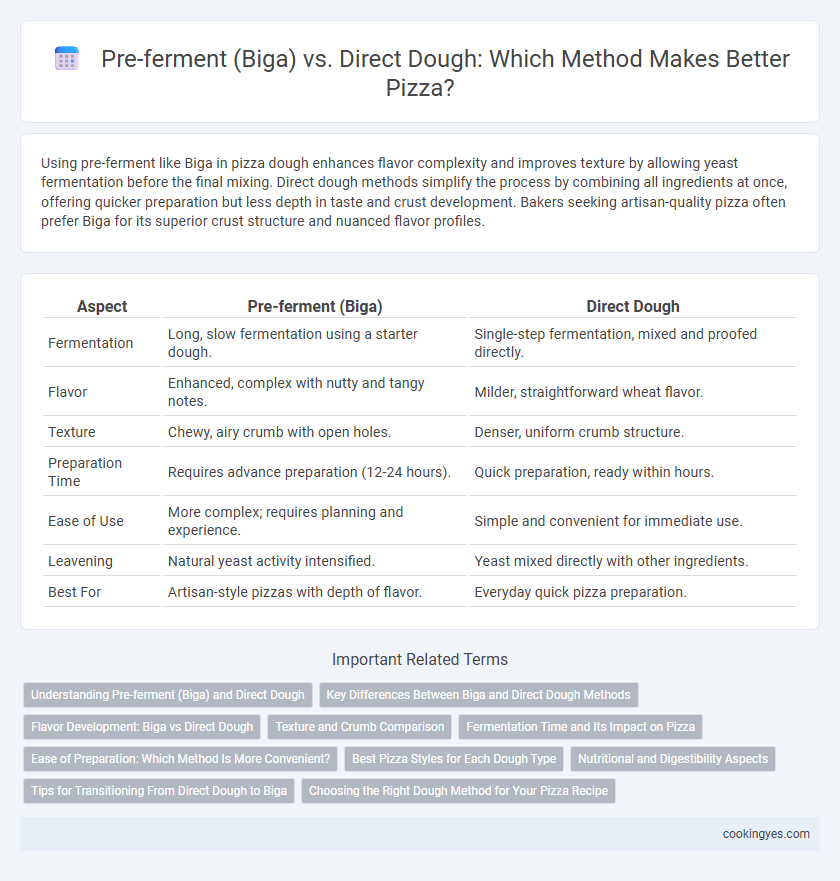Using pre-ferment like Biga in pizza dough enhances flavor complexity and improves texture by allowing yeast fermentation before the final mixing. Direct dough methods simplify the process by combining all ingredients at once, offering quicker preparation but less depth in taste and crust development. Bakers seeking artisan-quality pizza often prefer Biga for its superior crust structure and nuanced flavor profiles.
Table of Comparison
| Aspect | Pre-ferment (Biga) | Direct Dough |
|---|---|---|
| Fermentation | Long, slow fermentation using a starter dough. | Single-step fermentation, mixed and proofed directly. |
| Flavor | Enhanced, complex with nutty and tangy notes. | Milder, straightforward wheat flavor. |
| Texture | Chewy, airy crumb with open holes. | Denser, uniform crumb structure. |
| Preparation Time | Requires advance preparation (12-24 hours). | Quick preparation, ready within hours. |
| Ease of Use | More complex; requires planning and experience. | Simple and convenient for immediate use. |
| Leavening | Natural yeast activity intensified. | Yeast mixed directly with other ingredients. |
| Best For | Artisan-style pizzas with depth of flavor. | Everyday quick pizza preparation. |
Understanding Pre-ferment (Biga) and Direct Dough
Pre-ferment, known as Biga, is a dough starter made from flour, water, and a small amount of yeast, allowed to ferment for 12-16 hours to develop complex flavors and improve dough texture in pizza making. Direct dough combines all ingredients at once without fermentation, resulting in faster preparation but a less nuanced taste and chewier crust. Biga enhances gluten structure and aroma, making it ideal for traditional, artisanal pizzas, while direct dough suits quick, everyday pizza baking.
Key Differences Between Biga and Direct Dough Methods
Biga, a traditional Italian pre-ferment, enhances pizza dough by developing complex flavors and improving texture through extended fermentation, while direct dough mixes all ingredients simultaneously for quicker preparation but with less depth of taste. The fermentation time for biga typically ranges from 12 to 16 hours, promoting better gluten structure and gas retention, resulting in a lighter, airier crust compared to the denser consistency of direct dough. Bakers choosing biga benefit from enhanced dough extensibility and aroma, whereas direct dough suits fast-paced production with simplified handling and immediate baking.
Flavor Development: Biga vs Direct Dough
Biga, a pre-ferment used in pizza making, significantly enhances flavor development by allowing longer fermentation that produces complex organic acids and alcohols, resulting in a richer, more nuanced taste. Direct dough methods, mixing all ingredients at once and fermenting for a shorter time, yield a fresher but less developed flavor profile. The extended enzymatic activity in biga not only boosts aroma complexity but also improves texture and crust browning in the final pizza dough.
Texture and Crumb Comparison
Pre-ferment (Biga) in pizza dough enhances gluten development, resulting in a chewier texture and more open, airy crumb structure compared to direct dough methods. The slow fermentation process of biga produces more complex flavor compounds and improves dough strength, which contributes to a crispier crust and better oven spring. Direct dough yields a denser crumb and softer texture due to shorter fermentation, making it less suitable for achieving traditional artisan-style pizza qualities.
Fermentation Time and Its Impact on Pizza
Pre-ferment (Biga) involves a longer fermentation time, typically 12 to 16 hours, which enhances flavor complexity and improves dough structure by allowing natural enzymes to develop gluten and organic acids. Direct dough fermentation is faster, often completed within 1 to 2 hours, but may result in less depth of flavor and a simpler texture. Extended fermentation in Biga not only contributes to a chewier crust with better aeration but also improves digestibility by breaking down starches and proteins more thoroughly.
Ease of Preparation: Which Method Is More Convenient?
Pre-ferment dough, such as biga, requires advanced planning due to its extended fermentation time, making it less convenient for quick pizza preparation. Direct dough method streamlines the process by mixing all ingredients at once, offering a faster and simpler approach ideal for immediate use. For home cooks or pizzerias prioritizing ease of preparation, direct dough provides greater convenience without sacrificing essential dough qualities.
Best Pizza Styles for Each Dough Type
Biga, a pre-ferment dough, enhances flavor complexity and chewy texture, making it ideal for Neapolitan and Roman-style pizzas that benefit from longer fermentation. Direct dough, mixed and baked immediately, suits New York-style and Sicilian pizzas requiring a more straightforward, tender crumb with quicker preparation. The choice between biga and direct dough influences crust development, taste profile, and authenticity of various traditional pizza styles.
Nutritional and Digestibility Aspects
Using pre-ferment (biga) in pizza dough enhances nutritional value by promoting natural fermentation, which increases the bioavailability of minerals like iron and zinc and reduces phytate content. This fermentation process also improves digestibility by breaking down complex carbohydrates and gluten proteins, making the pizza easier on the stomach compared to direct dough methods. Direct dough lacks this extended fermentation, resulting in lower nutrient absorption and potentially greater digestive discomfort.
Tips for Transitioning From Direct Dough to Biga
When transitioning from direct dough to biga for pizza making, gradually introduce the pre-ferment by replacing 20-30% of the flour with biga in the initial batches to monitor fermentation effects. Adjust hydration levels, as biga tends to absorb more water, and extend fermentation times to enhance dough flavor and texture. Maintain consistent temperature control between 18-22degC during fermentation to optimize yeast activity and gluten development for a superior pizza crust.
Choosing the Right Dough Method for Your Pizza Recipe
Choosing between Pre-ferment (Biga) and direct dough methods significantly impacts pizza texture and flavor development. Biga, a slow-fermented pre-ferment, enhances gluten strength and creates a complex, airy crust with improved fermentation notes, ideal for traditional artisan pizzas. Direct dough, mixing ingredients all at once, offers faster preparation and yields a softer, more uniform crust, suitable for everyday or commercially produced pizzas.
Pre-ferment (Biga) vs Direct dough for pizza making Infographic

 cookingyes.com
cookingyes.com